| ________________
CM . . .
. Volume XIV Number 18. . . .May 2, 2008 
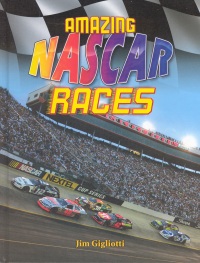 |
Amazing NASCAR Races. (NASCAR).
Jim Gigliotti.
St. Catharines, ON: Crabtree, 2008.
32 pp., pbk. & hc., $10.95 (pbk.), $20.76 (rlb.).
ISBN 978-0-7787-3199-3 (pbk.), ISBN 978-0-7787-3191-7 (rlb).
Subject Headings:
NASCAR (Association)-Juvenile literature.
Stock car racing-United States-History-Juvenile literature.
Grades 4-7 / Ages 9-12.
Review by Gail Hamilton.
***½ /4
|
| |
|
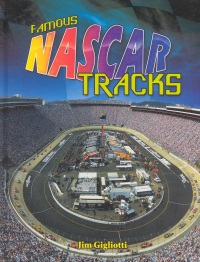 |
Famous NASCAR Tracks. (NASCAR).
Jim Gigliotti.
St. Catharines, ON: Crabtree, 2008.
32 pp., pbk. & hc., $10.95 (pbk.), $20.76 (rlb.).
ISBN 978-0-7787-3196-2 (pbk.), ISBN 978-0-7787-3188-7 (rlb).
Subject Headings:
NASCAR (Association)-Juvenile literature.
Stock car racing-United States-Juvenile literature.
Race tracks (Automobile racing)-United States-Juvenile literature.
Grades 4-7 / Ages 9-12.
Review by Gail Hamilton.
***½ /4
|
| |
|
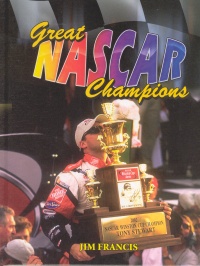 |
Great NASCAR Champions. (NASCAR).
Jim Francis.
St. Catharines, ON: Crabtree, 2008.
32 pp., pbk. & hc., $10.95 (pbk.), $20.76 (rlb).
ISBN 978-0-7787-3195-5 (pbk.), ISBN 978-0-7787-3187-0 (rlb).
Subject Headings:
NASCAR (Association)-Juvenile literature.
Automobile racing drivers-United States-Biography-Juvenile literature.
Stock car drivers-United States-Biography-Juvenile literature.
Grades 4-7 / Ages 9-12.
Review by Gail Hamilton.
***½ /4
|
| |
|
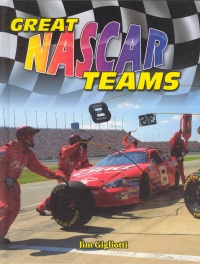 |
Great NASCAR Teams. (NASCAR).
Jim Gigliotti.
St. Catharines, ON: Crabtree, 2008.
32 pp., pbk. & hc., $10.95 (pbk.), $20.76 (rlb.).
ISBN 978-0-7787-3198-6 (pbk.), ISBN 978-0-7787-3190-0 (rlb).
Subject Headings:
NASCAR (Association)-Juvenile literature.
Stock car racing-United States-Juvenile literature.
Stock car drivers-United States-Biography-Juvenile literature.
Grades 4-7 / Ages 9-12.
Review by Gail Hamilton.
***½ /4
|
| |
|
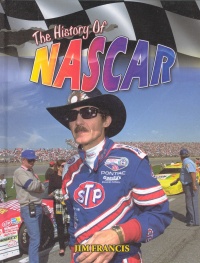 |
The History of NASCAR. (NASCAR).
Jim Francis.
St. Catharines, ON: Crabtree, 2008.
32 pp., pbk. & hc., $10.95 (pbk.), $20.76 (rlb.).
ISBN 978-0-7787-3194-8 (pbk.), ISBN 978-0-7787-3186-3 (rlb).
Subject Headings:
NASCAR (Association)-History-Juvenile literature.
Stock car racing-United States-History-Juvenile literature.
Stock cars (Automobiles)-Juvenile literature.
Grades 4-7 / Ages 9-12.
Review by Gail Hamilton.
***½ /4
|
| |
|
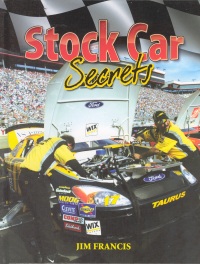 |
Stock Car Secrets. (NASCAR).
Jim Francis.
St. Catharines, ON: Crabtree, 2008.
32 pp., pbk. & hc., $10.95 (pbk.), $20.76 (rlb).
ISBN 978-0-7787-3197-9 (pbk.), ISBN 978-0-7787-3189-4 (rlb).
Subject Heading:
Stock cars (Automobiles)-Juvenile literature.
Grades 4-7 / Ages 9-12.
Review by Gail Hamilton.
***½ /4
|
| |
|

excerpt:
As the 2000s neared, NASCAR saw a chance to make a huge leap forward. They matched TV networks and cable channels against each other, looking for the best deal. What they got was light years away from what Big Bill France Sr. could ever have imagined 50 years earlier way down South. In late 1999, NASCAR signed a deal with several TV networks that would pay the racing group $2.4 billion. Billion, with a "B"! It was one of the largest TV contracts ever signed and immediately meant that NASCAR would be on TV more often, and in more places, than ever before. This meant more time for sponsors to get their messages on TV, more money for driver earnings, and more money to spend on technology. The TV contract pushed NASCAR forward faster than any previous event. (From The History of NASCAR.)
Car buffs and racing aficionados alike will throughly enjoy this six-volume series focusing on the history, cars and people involved in NASCAR. Three of the titles are written by Jim Francis and three by Jim Gigliotti, but the writing style is so similar that there is no perceivable difference among the titles. The books average eight chapters and include a table of contents, a glossary and an index. There are plenty of bright, colourful photographs, diagrams and charts as well as some black and white photographs. These add visual punch to the engaging text and will definitely appeal to readers. Additional information is provided in text boxes interspersed throughout the books.
Amazing NASCAR Races features the most memorable races in NASCAR's history- some of them having dramatic or photo finishes. One example is the race in which three drivers—Lee Petty, Johnny Beauchamp and Joe Weatherly—crossed the finish line at the same time. Officials couldn't tell who won but declared Beauchamp the winner. After reviewing film footage, it was discovered that Petty had actually won the race by a mere 24 inches (61 cm). Other topics covered in this title include famous racing families, such as the Pettys, Pearsons, Allisons and Earnhardts, the racing points system, the role of inspectors to ensure that cars are safe and that all the equipment is "legal," and the sometimes dangerous or heartbreaking races.
Famous NASCAR Tracks explains the differences among the four different types of tracks—superspeedways, intermediate tracks, short tracks and road courses—and the different driving methods required on each one. Many well-known tracks are featured- Daytona International Speedway (the Daytona 500 is often nicknamed the "Super Bowl of NASCAR"), Talladega and the Indianapolis Motor Speedway, just to name a few. The laws of aerodynamics, in terms of track design, are mentioned along with popular movies filmed at race tracks and memorable events in racing history. One such moment occurred at Daytona a month after Dale Earnhardt Sr. was killed in a crash at the Daytona 500. The speedway released thousands of black balloons on the third lap (Earnhardt's number was 3) of the Cracker Barrel 500. At the back of the book is a page entitled Facts and Figures which lists tracks by category, length, number of banks (degrees of steepness) and victories.
Great NASCAR Champions begins with an explanation of how the points system used to determine the winner of the Winston Cup has recently changed (2004) so that fan interest will not wane at the end of the season. Champions featured include Richard (the "King of NASCAR") Petty and Lee Petty, David Pearson, Cale Yarborough, Dale Earnhardt Sr. and Jr., and Jeff Gordon. There is information about their early years in racing, spectacular crashes, track troubles, wins, records set and the ways in which they influenced racing. Newcomers on the scene are also showcased. A table showing famous racing families is provided. Finally, there is information about how the prize money is divided.
Though the crowds cheer for the drivers, no driver could be successful without his team. Great NASCAR Teams focuses on the various roles played by the different members of the team. Beginning with the team owner who manages the day-to-day business, this title also covers the duties of the crew chief (likened to a coach), the pit crew which can number up to 18, the spotter, the sponsors and the officials. Pioneers in the car racing business as well as several racing teams are highlighted.
NASCAR had its humble beginnings in the southern USA in the 1920s and 1930s. Moonshine runners, accustomed to driving fast to evade the police, gradually began to race each other on rough dirt tracks. The History of NASCAR features the founders of NASCAR, racing families and champions, improvements to cars and engines over the years, and the growth of car racing in popularity as seen in the increase in television coverage and sponsorship money. Readers will also learn about the four different types of tracks, the formal races, the points system and the racing of pickup trucks which started in 1995.
Stock Car Secrets will be especially interesting to readers. This title highlights the changes in safety and design features of race cars and the role that computers and technology have played in these changes. Starting in 2008, all teams will use the same race car body style and shape to ensure fairness, safety and cost effectiveness. In this book, readers will find out how a car is made, from start to finish, and why race cars do not have dashboards or side mirrors and why the tires do not have treads. Safety devices, such as the head and neck system (HANS), different tires for different types of tracks, and the final inspection process are also discussed. One innovation, designed to save time at a pit stop, is the window. It is made of strong plastic with 3-4 layers of sticky clear film that can be peeled off, one layer at a time, instead of someone having to wash the window.
In a series such as this one, there is bound to be some overlap among the titles. However, with the exception of information about some of the most famous race car drivers, there is surprisingly very little. These titles are likely to draw male readers in like a magnet.
Recommended.
Gail Hamilton is a teacher-librarian in Winnipeg, MB.

To comment
on this title or this review, send mail to cm@umanitoba.ca.
Copyright © the Manitoba Library Association. Reproduction for personal
use is permitted only if this copyright notice is maintained. Any
other reproduction is prohibited without permission.
NEXT REVIEW |
TABLE OF CONTENTS FOR THIS ISSUE
- May 2, 2008.
AUTHORS |
TITLES |
MEDIA REVIEWS |
PROFILES |
BACK ISSUES |
SEARCH |
CMARCHIVE |
HOME |





